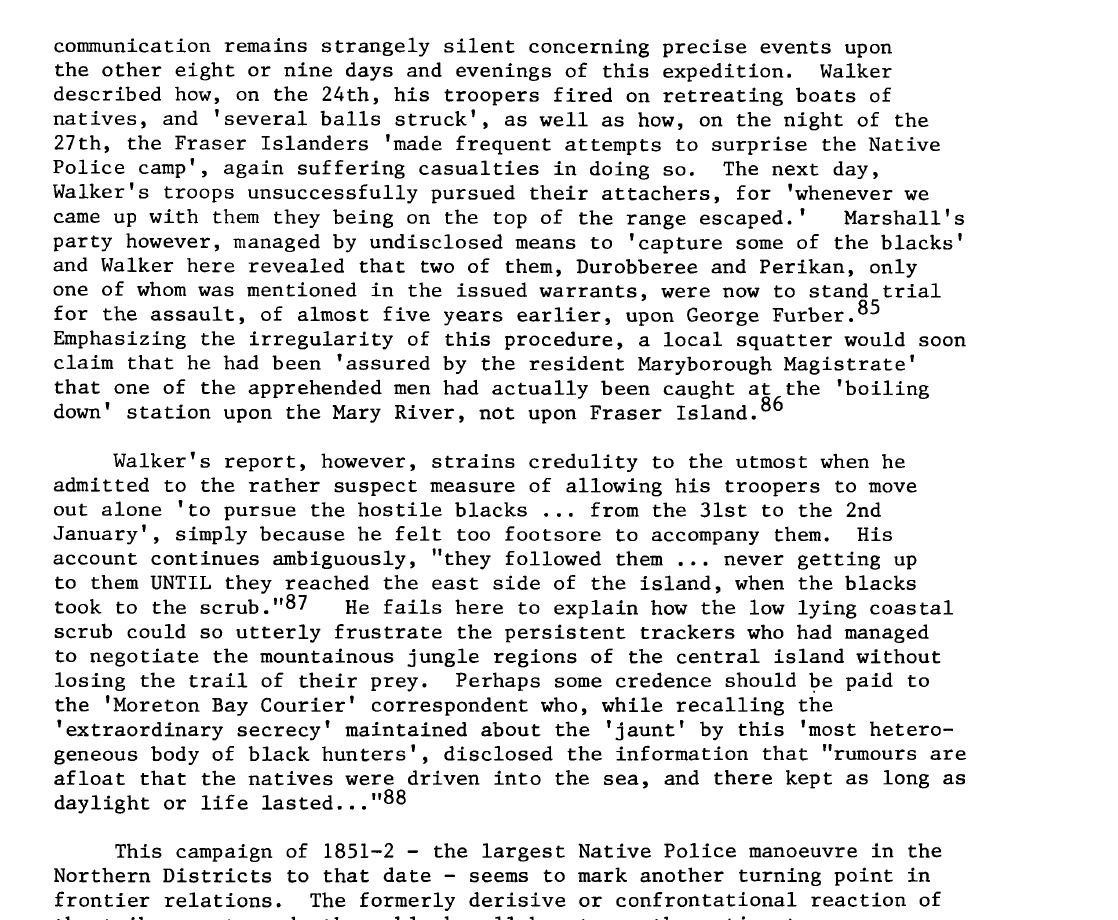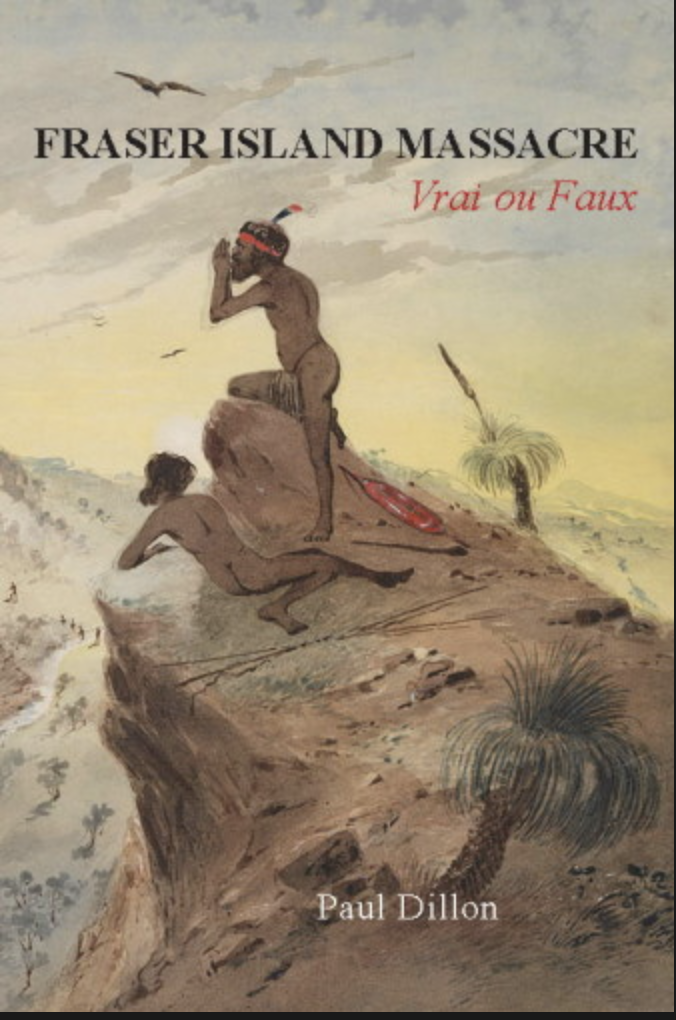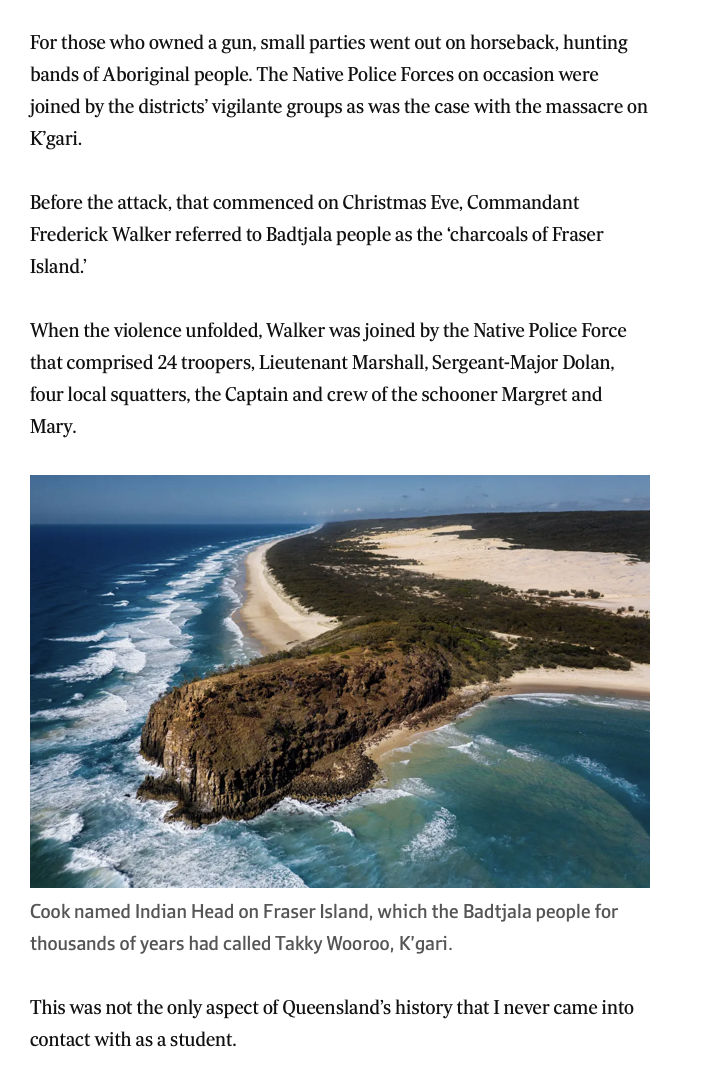$1000 History Prize - Idea Laundering on Fraser Island
Ryan: “I had another reference referring to a report by John Oxley, who was a surveyor; he said “too many aborigines were being killed”
Interviewer: “Okay, but how did you extrapolate from his words saying, “too many aborigines had been killed” to, ”about a hundred lost their lives”?
Ryan: [Oh] “yes, but historians are always making up figures."
- The late Professor Lyndall Ryan AO, FAHA [1943 – 2024] being questioned on how she arrived at an Aboriginal death toll of 100, in an interview with Helen Dalley on Nine’s Sunday program in 2003 [watch from 01:00],
Normally, one shouldn’t speak ill of the dead, but it has been a year since the professor has passed so, in the interests of Truth-Telling, this post looks at Professor Ryan’s uncanny knack for just making up figures and how her legacy has provided cover for a massive “idea laundering” racket within academia.
Just like the laundering of ill-gotten money into socially acceptable funds, idea laundering involves the moving of false or misleading notions and information from unverifiable sources through increasing levels of respectability until, finally, they merge into the mainstream, where they are adopted as ‘fact’ and ‘knowledge’ and then further cited by reputable commentators.
To familarize oneself with this contemporary and very influential phenomenon, readers should first read my article in Quadrant here.
This post is an illustration of “idea laundering” in action at the University of Newcastle by the academics responsible for the Colonial Frontier Massacre Map, the late Professor Lyndall Ryan who created the map, and Dr Bill Pascoe, who now leads the team.
Figure 1 - Dr Bill Pascoe (L) now leads the late Professor Lyndall Ryan’s (R) Colonial Massacre Map project at the University of Newcastle. Source
The “idea” being laundered is the claim by the academics that “50” or even “100” Aborigines were massacred on Fraser Island in 1851/2 during a Native Police expedition lead by Commandant Frederick Walker.
The citations used by the University of Newcastle’s Colonial Frontier Massacre Map to justify the ‘massacre’ death toll of “50 or “100” will be shown to be low-grade secondary sources based on hearsay at best, or a total fabrication at worst.
It will also be shown that the “idea” that a massacre of 50 or 100 occurred has been so successfully “laundered” by the university to the point where the myth is now well accepted within the mainstream media and frequently cited by third parties.
The official government records (Reference 1) have been relegated to obscurity by the academy, as a way of hiding the real and inconvenient truth that no massacre occurred. These reports recorded that (only) two ‘blacks’ were killed and unknown number were probably wounded, and may have died later, but no evidence exists that six or more people were killed [the number set by the academics to qualify as a ‘massacre’].
Fraser Island Massacre History Prize of $1000
To create interest in others to solve this contradiction between the official death toll of two and Professor Ryan’s 50 or 100, we are offering $1000 to the first person, or group, who can provide credible documentary, archaeological, or other suitable and real, evidence that 50 or more people were massacred during the 1851/2 Native Police excursion to Fraser Island headed by Commandant Frederick Walker.
Applications are especially welcome from the University of Newcastle team, whose current sources that they rely upon for “evidence”, to support Professor Ryan’s number of 50 or 100, are plainly just rubbish.
The Bigger Idea to be Laundered: That The Settlement of Australia was Very Violent
Some readers may be wondering why the specific numbers of Aboriginal deaths is worthy of research. It is true that any deaths are lamentable but there is a political and moral difference between the inadvertent killing of two Aborigines during an affray and/or a bungled arrest, and the deliberate, premeditated massacring of 50 or 100 people at the hands of a large-scale police operation. Instead of leaving the history books as they correctly were, with the death toll as two, modern-day academics, who are anti-British and anti-colonialists, need to promote the ‘idea’ that Australia was settled very violently, as an “invasion” or “war” and not relatively peacefully by “settlement”. The ultimate aim of these revisionists is to convince the Australian sovereign peoples that they don’t own Australia - instead it was ‘stolen’ during a ‘war’ without treaty or compensation and it needs to be handed back to a new, self-appointed, political lobby group who claim to be the rightful Aboriginal owners [See the media commentary regarding the 30 June 2025 reports from Victoria’s Yoorrook Commission which supports this analysis].
One way to progress this political agenda is to promote the so-called ‘Frontier War’ thesis of historian Henry Reynolds, who has claimed many thousands of Aborigines were killed by settlers, pastoralists and the Native Police forces during colonisation. His estimates of the number of Aboriginal casualities has steadily increased over the past 5 decades of his academic career - from some 10,000 in 1972 to around 100,000 as he claims today (see Video).
It is my contention that the ‘idea’ that Australia’s settlement was very violent (compared to other colonisations) is a “false and misleading notion” which Reynolds has blown out of all proportion by relying upon “unverifiable sources.” The sources for his ‘idea’ are, as he claims, predominately newspaper articles based on hearsay, personal opinion, editorial slant and/or from self-interested parties such as missionaries, squatters, politicians and newspaper editors. [See also Refs 2 & 3]
As mentioned in the above video, the late Professor Ryan became a supporter of Reynolds’ thesis, and she has been instrumental in giving these low-grade, unverifiable and often just hearsay newspaper reports of killings a level of respectability by “laundering” them through University of Newcastle. These ‘ideas’ then emerge into the mainstream media, with Professor Ryan’s ‘academic stamp of approval’. The unscholarly ideas and notions, which have no real evidence to back them, are now readily adopted as ‘fact’ and ‘knowledge’. They are now so well “laundered” that they are further cited by reputable commentators, such the Guardian (Figure 9), the Australian Financial Review (Figure 10A,B&C), and private consultants (Figure 13 & 14) whose recommendations then pave the way for local community groups (Figures 12) , councils and even state governments such as the Queensland Anti-Discrimination Commission (Figures 11) to believe in the myth.
The success of this ‘idea laundering’ is partly due to the academics’ idea having at least some element of truth in it - there were some horrific and well verified and documented massacres of Aboriginal people (see Myall Creek) - but these few massacres can’t be extrapolated to a full-scale ‘frontier war’ thesis without a lot more evidence.
1. University of Newcastle’s First Version for the Fraser Island ‘Massacre’
Up until 2022, the Colonial Frontier Massacre Map put the death toll of the so-called Fraser Island ‘massacre’ at “100 Aboriginal people” (Figure 2). This number was based on the two cited sources - Lauer (1977) [Figures 3 & 4] and the Sydney Morning Herald newspaper of 22 January 1852 (Figure 5).
Readers are invited to check these two sources themselves to determine where a death toll of “100 Aboriginal people” is mentioned - the first to do so is in the running for the $1000 prize money. None of our researchers could find any mention of a death toll of “100”.
Figure 2 - University of Newcastle Colonial Frontier Massacre Map entry for the Fraser Island massacre of 1851/2 based on two sources Lauer and the Sydney Morning Herald Newspaper. Source: Internet archive March 2022
Figure 3 - The first source, “Lauer 1977”, cited in the Colonial Frontier Massacre Map. Source: Full Book in pdf here
Figure 4A - The only paper within “Lauer 1977” that deals with the Fraser Island massacre is that by Evans & Walker on pages 39-105. (Figure 4B) They specifically mention the Fraser Island expedition only on pages 53 & 54. See Figures 4C&D. Nowhere do they mention a massacre of “50” or “100” Aborigines. Source: see Figure 3.
Figure 4B - The only paper in Lauer that deals with the Fraser Island Expedition
Figure 4C - Mention of Walker’s expedition to Fraser island. Nowhere do they mention a massacre of “50” or “100” Aborigines. [Source Lauer p53]
Figure 4D - Mention of Walker’s expedition to Fraser island (cont). Nowhere do they mention a massacre of “50” or “100” Aborigines.[Source Lauer p54]
Figure 5 - The second source, “SMH January 22, 1852”, cited in the Colonial Frontier Massacre Map. Source: The Sydney Morning Herald (SMH) Fraser’s Island, Thu 22 Jan 1852 , p2
The SMH article appears to rely on the official report of the expedition, written by its leader Frederick Walker two days after his return. (see Reference 1 below for full report transcript). The SMH mentions no death toll, let alone one of “50” or “100”.
2. University of Newcastle’s Second Version for the Fraser Island ‘Massacre’
Sometime after 2022, the Colonial Frontier Massacre Map entry was amended by lowering the claimed death toll to read “50 Aboriginal or Torres Strait Islander people” (Figure 6A) [See also Ref 4]. This amendment appeared to result from a new additional reference source, cited as Collins (2000) (Figure 6B).
A copy of this new source is shown in Figure 7. It is a handwritten, single page ‘oral history’ recollection written by a Vic Collins in 2000. He claims his father, Bill Collins, told him this story which Bill had learnt as a teenage boy from another man, an old convict, who told the story on his death bed in 1896. The convict’s story was purported to be about a massacre at Teewah Beach just north of Noosa. Given that this is some 180km south of Fraser Island’s Indian Head, where the ‘massacre’ of 50 Aborigines is claimed to have occurred, it is difficult to understand why the university has cited this single page note, written in the year 2000, as being valid evidence for events that were said to have occurred some 150 years prior and 180km away.
Given that Collins makes no mention of a death toll of “50” it is unclear as to why the academics running the Massacre Map cite his oral history as a credible source for their second version amendment. Historical research should be done like investigative journalism - seeking out information from the primary sources, from the people who were actually there who witnessed and wrote about the events with additional support from justifiable and corroborating secondary sources. Hearsay is just that and should not be considered a primary source.
This begs the question, why didn’t the university’s academics even cite the primary evidence of the guy who was there on Fraser Island directing operations - Frederick Walker in his report of 5 January 1852? (See Reference 1) - or even the secondary source, Paul Dillon’s book, Fraser Island Massacre, where he publishes an analysis of all the primary sources in forensic detail?
One can only conclude that Walker’s and Dillon’s evidence goes against the Ryan/Reynolds/University of Newcastle narrative that the Queensland Native Police were invariably massacring Aborigines on each of their patrols and expeditions. It appears that for the university ‘truth-telling’ only works one way.
Figure 6A - University of Newcastle’s Second Version for the Fraser Island ‘Massacre’ entry in the Colonial Frontier Massacre Map, made sometime after 2022 . This second version lowers the claimed death toll to read, “50 Aboriginal or Torres Strait Islander people” . This amendment appears to result from the ‘new’ additional reference source, cited as Collins (2000) (Figure 6B). Source
Figure 6B - See above in Figure 6A
Figure 7 - Vic Collins [1929-2003] Handwritten account of an Aboriginal massacre at Teewah, (2000). Source: John Oxley Library, State Library of Queensland. Record number 99183592720302061
Collins’ narrative purports to relate to a ‘massacar [sic] of Aborigines on Teewah Beach'.
However, according to GoogleMaps Teewah Beach is some 180km south of Indian Head [Takky Wooroo] on Fraser Island where today the Native Police ‘massacre’ of 50 Aborigines is claimed to have occurred (Figure 8).
Based on the above, it is hard for the academics at the University of Newcastle to avoid the charge of “idea laundering.”
Figure 8 - GoogleMap screenshot showing that Teewah beach lies on the mainland some 180km south of Indian Head on Fraser Island
After this successful “laundering” of the “idea” by the University of Newcastle academics, the ‘Fraser Island massacre myth’ then gets picked up by parts of the media, such as the Guardian and the AFR:
Figure 9 - Excerpt for entry on so-called - Fraser Island ‘Massacre’ 1851/2 Source: The Guardian Killing Times Interactive Map
Note also in the AFR article below, the use of a sea-turtle skull as a ‘prop’ to enhance the gravity of the mythical claims. Does Fiona Foley and the AFR really think that the readers will be fooled into believing this is a skull of one of the Aboriginal massacre victims?
Figure 10A - Source
Figure 10B - Fiona Foley (and presumably the AFR editorial team), with a sea-turtle skull as a prop claiming an Aboriginal massacre occurred at Indian Head [Takky Wooroo].
Figure 10C - The claimed site on the far northe eastern side of Fraser island for the `massacre myth.’
Figure 10D - Skull of a Loggerhead Turtle . Source
Now that the ‘Fraser Island massacre myth’ has been laundered by reputable sources such as the University of Newcastle, The Guardian and the AFR, it can then be confidently taken up by other commentators. It becomes a case of ``no one ever got sacked for quoting the Australian Financial Review.”
Thus, the Anti-Discrimmination Commission of Queensland propagates the myth further. They slanderously turn a police action to arrest felons and murderers into a ``hunting expedition over the Christmas period” leading to the `massacre’ at Indian Head. (Figure 11E)
Figures 11A ,B &C - Report by the Anti-Discrimination Commission of Queensland.
Figures 11D - Excerpt on Masaacres from a Report by the Anti-Discrimination Commission of Queensland. Source: Page 8
Figures 11E - Excerpt on Masaacres from a Report by the Anti-Discrimination Commission of Queensland. Source: Page 9
Local community organises are not immune to the `viral infection’ of Idea laundering. The Fraser Island Defence Organisation ‘launders’ the myth further within its membership:
Figure 12A - Source
Figure 12B - Source
Even more worrying is when supposedly “expert” commercial organisations fall for the ‘idea laundering’ by disregarding the Western scientific method of critical analysis based of evidence and facts.
The consulting archaeologist, Dr Anna Weisse openly admits that no real evidence exists for the massacre:
The location of the [so-called] massacre is not clearly stated in any of the historical sources. In addition, McNiven’s (1994, 1998) comprehensive archaeological site survey of Takky Wooroo [Indian Head] and nearby Corroboree Beach did not locate any human remains…
Nevertheless, considering the details in the historical records of the 1851–1852 massacre and the lack of physical evidence for remains at Takky Wooroo, it is not possible to link Takky Wooroo to the massacre event definitively. For this reason, intangible evidence in the form of oral history and local knowledge must be introduced into the research.
Figure 13 - Dr Anna Weisse, Four Corners Senior Archeologist and Business Manager - an archaeologist and anthropologist with a specialised focus on bridging the gap between First Nations communities and other stakeholder groups. Source
Figure 14 - Source
Figure 15 - ibid., p155
Figure 16 - ibid., p155
Figure 17 - ibid., p155
Figure 18 - ibid., p155
It is a very sad indictment on the state of critical thinking, history, archaeology and science in Australia where a commercial company produces a report that gives equal credence to oral history “stories” over real evidence and facts. Australia as a country of the Enlightenment, Science and proper scholarship is now unfortunately over. All reports are now suspect, loaded as they are with ‘laundered’ falsehoods and political ideology.
References
The official report by Commandant Frederick Walker dated 5 January 1852, two days after his return from the Fraser Island Native Police expedition. The original handwritten copy here [Source: QSL Reel A2.23 p820-30] and a transcription by author and lawyer Paul Dillon, by courtesy and published in Paul Dillion (Fraser Island Massacre, Connor Court, 2022), pages 212-14
Why Isn't There Any Physical Evidence of the So-called 'Frontier Wars'?
The change of the collective term for the alleged victims from “Aboriginal people” pre-2022, to “Aboriginal or Torres Strait Islander people” post-2022 is a dead givaway that ideology is ‘marching through the institution’ at University of Newcastle. For, how on earth could any Torres Strait Islander people be on Fraser island in 1851 so that they could be massacred along with the local Aborigines? Queensland did not start annexing the Torres Strait Islands, some 2000km north of Fraser Island, until some twenty years later. The researcher down at the Massacre Map is now so brainwashed that every sentence must conform to the correct DEI terminology in preference to its historical accuracy.




































